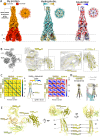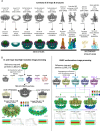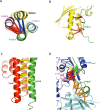Cryo-EM structure of a conjugative type IV secretion system suggests a molecular switch regulating pilus biogenesis
- PMID: 38886579
- PMCID: PMC11294453
- DOI: 10.1038/s44318-024-00135-z
Cryo-EM structure of a conjugative type IV secretion system suggests a molecular switch regulating pilus biogenesis
Abstract
Conjugative type IV secretion systems (T4SS) mediate bacterial conjugation, a process that enables the unidirectional exchange of genetic materials between a donor and a recipient bacterial cell. Bacterial conjugation is the primary means by which antibiotic resistance genes spread among bacterial populations (Barlow 2009; Virolle et al, 2020). Conjugative T4SSs form pili: long extracellular filaments that connect with recipient cells. Previously, we solved the cryo-electron microscopy (cryo-EM) structure of a conjugative T4SS. In this article, based on additional data, we present a more complete T4SS cryo-EM structure than that published earlier. Novel structural features include details of the mismatch symmetry within the OMCC, the presence of a fourth VirB8 subunit in the asymmetric unit of both the arches and the inner membrane complex (IMC), and a hydrophobic VirB5 tip in the distal end of the stalk. Additionally, we provide previously undescribed structural insights into the protein VirB10 and identify a novel regulation mechanism of T4SS-mediated pilus biogenesis by this protein, that we believe is a key checkpoint for this process.
Keywords: Antibiotic Resistance; Bacterial Conjugation; Cryo-EM; T4SS; Type IV Secretion System.
© 2024. The Author(s).
Figures









Similar articles
-
Cryo-EM structure of a type IV secretion system.Nature. 2022 Jul;607(7917):191-196. doi: 10.1038/s41586-022-04859-y. Epub 2022 Jun 22. Nature. 2022. PMID: 35732732 Free PMC article.
-
Architecture of the outer-membrane core complex from a conjugative type IV secretion system.Nat Commun. 2021 Nov 25;12(1):6834. doi: 10.1038/s41467-021-27178-8. Nat Commun. 2021. PMID: 34824240 Free PMC article.
-
In Situ Visualization of the pKM101-Encoded Type IV Secretion System Reveals a Highly Symmetric ATPase Energy Center.mBio. 2021 Oct 26;12(5):e0246521. doi: 10.1128/mBio.02465-21. Epub 2021 Oct 12. mBio. 2021. PMID: 34634937 Free PMC article.
-
Comparative Analysis of T4SS Molecular Architectures.J Microbiol Biotechnol. 2023 Dec 28;33(12):1543-1551. doi: 10.4014/jmb.2307.07006. Epub 2023 Aug 1. J Microbiol Biotechnol. 2023. PMID: 37528551 Free PMC article. Review.
-
From conjugation to T4S systems in Gram-negative bacteria: a mechanistic biology perspective.EMBO Rep. 2019 Feb;20(2):e47012. doi: 10.15252/embr.201847012. Epub 2019 Jan 2. EMBO Rep. 2019. PMID: 30602585 Free PMC article. Review.
Cited by
-
Elucidating assembly and function of VirB8 cell wall subunits refines the DNA translocation model in Gram-positive T4SSs.Sci Adv. 2025 Jan 24;11(4):eadq5975. doi: 10.1126/sciadv.adq5975. Epub 2025 Jan 22. Sci Adv. 2025. PMID: 39841841 Free PMC article.
-
Species-specific components of the Helicobacter pylori Cag type IV secretion system.Infect Immun. 2025 May 13;93(5):e0049324. doi: 10.1128/iai.00493-24. Epub 2025 Apr 10. Infect Immun. 2025. PMID: 40208031 Free PMC article.
-
Cryo-EM structure and evolutionary history of the conjugation surface exclusion protein TraT.Nat Commun. 2025 Jan 14;16(1):659. doi: 10.1038/s41467-025-55834-w. Nat Commun. 2025. PMID: 39809778 Free PMC article.
References
-
- Adams PD, Afonine PV, Bunkoczi G, Chen VB, Davis IW, Echols N, Headd JJ, Hung LW, Kapral GJ, Grosse-Kunstleve RW et al (2010) PHENIX: a comprehensive Python-based system for macromolecular structure solution. Acta Crystallogr D Biol Crystallogr 66:213–221 10.1107/S0907444909052925 - DOI - PMC - PubMed
MeSH terms
Substances
Grants and funding
LinkOut - more resources
Full Text Sources

